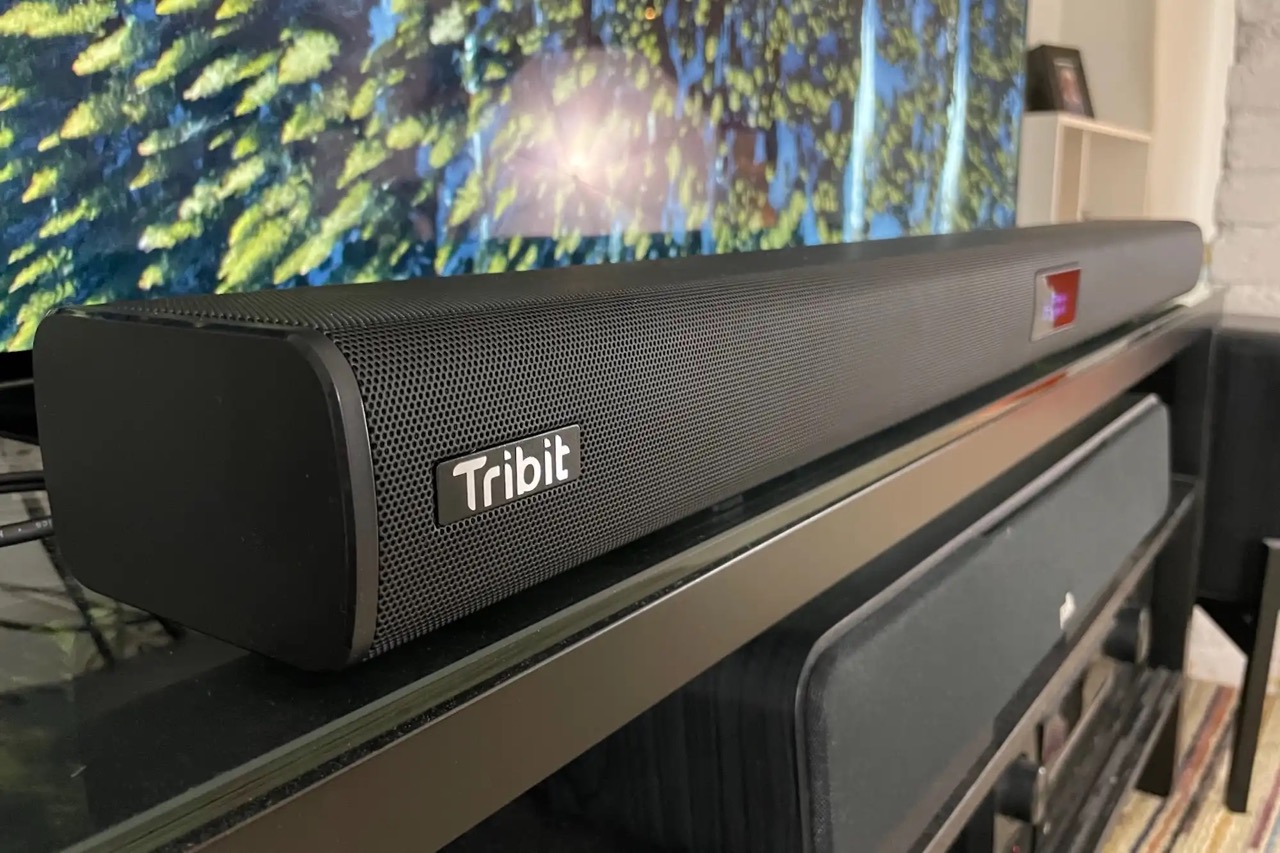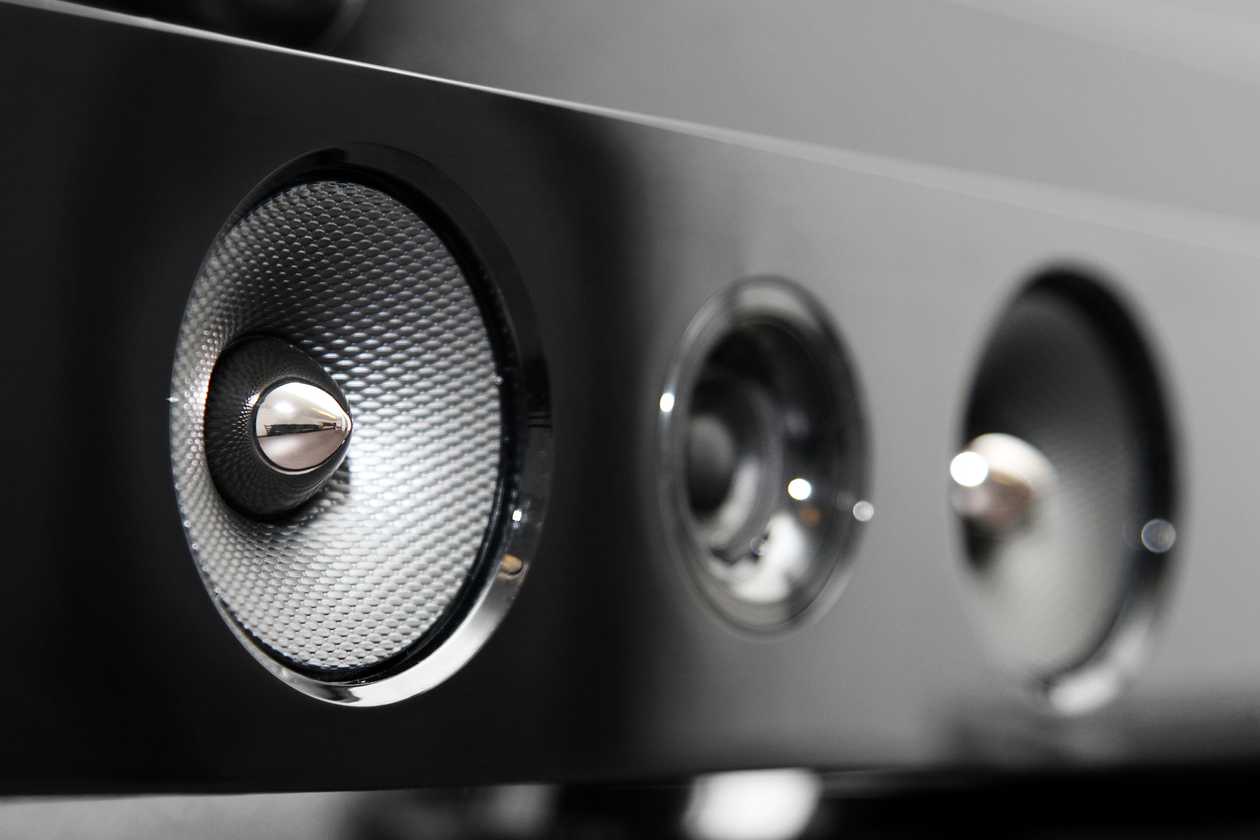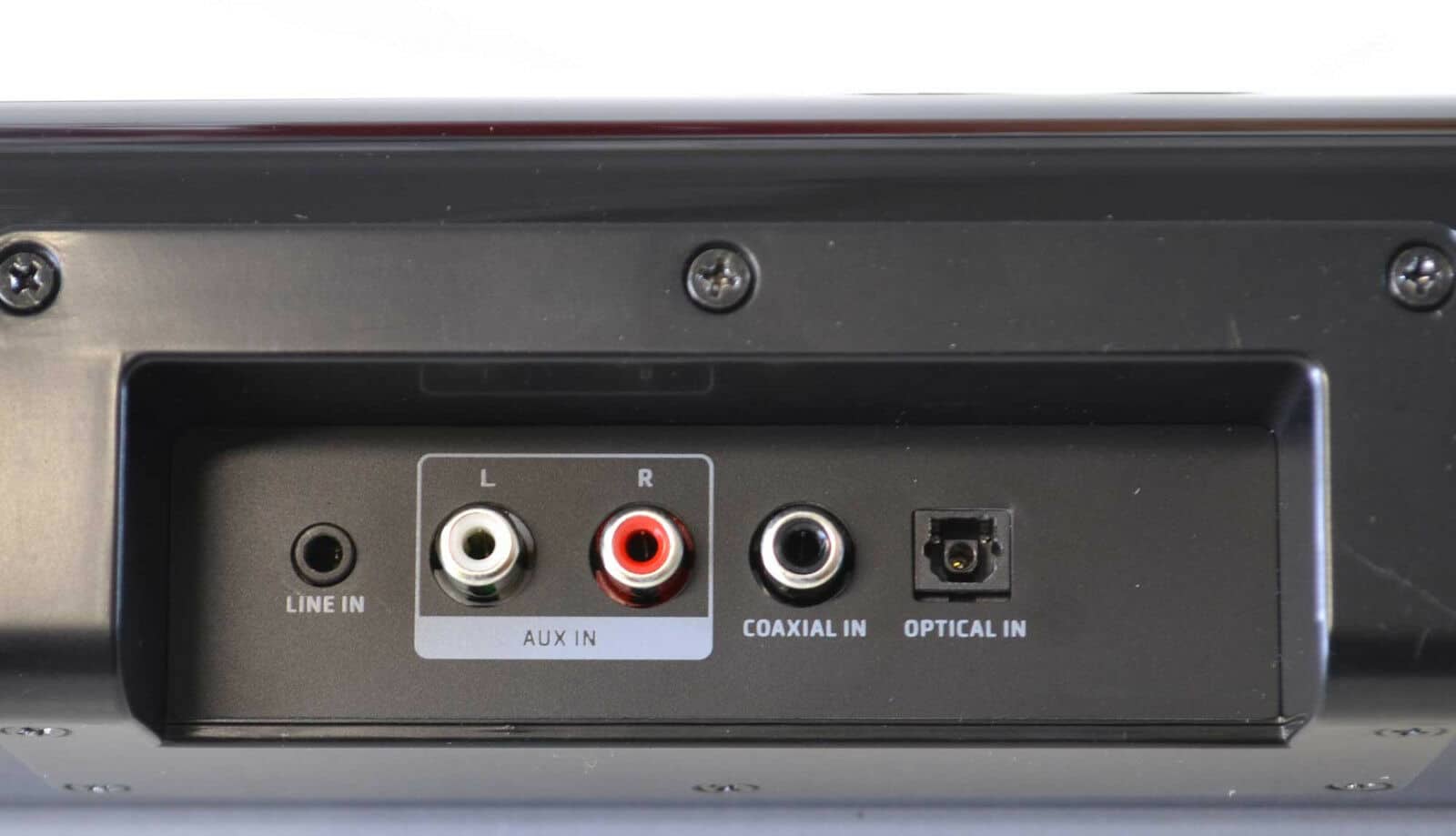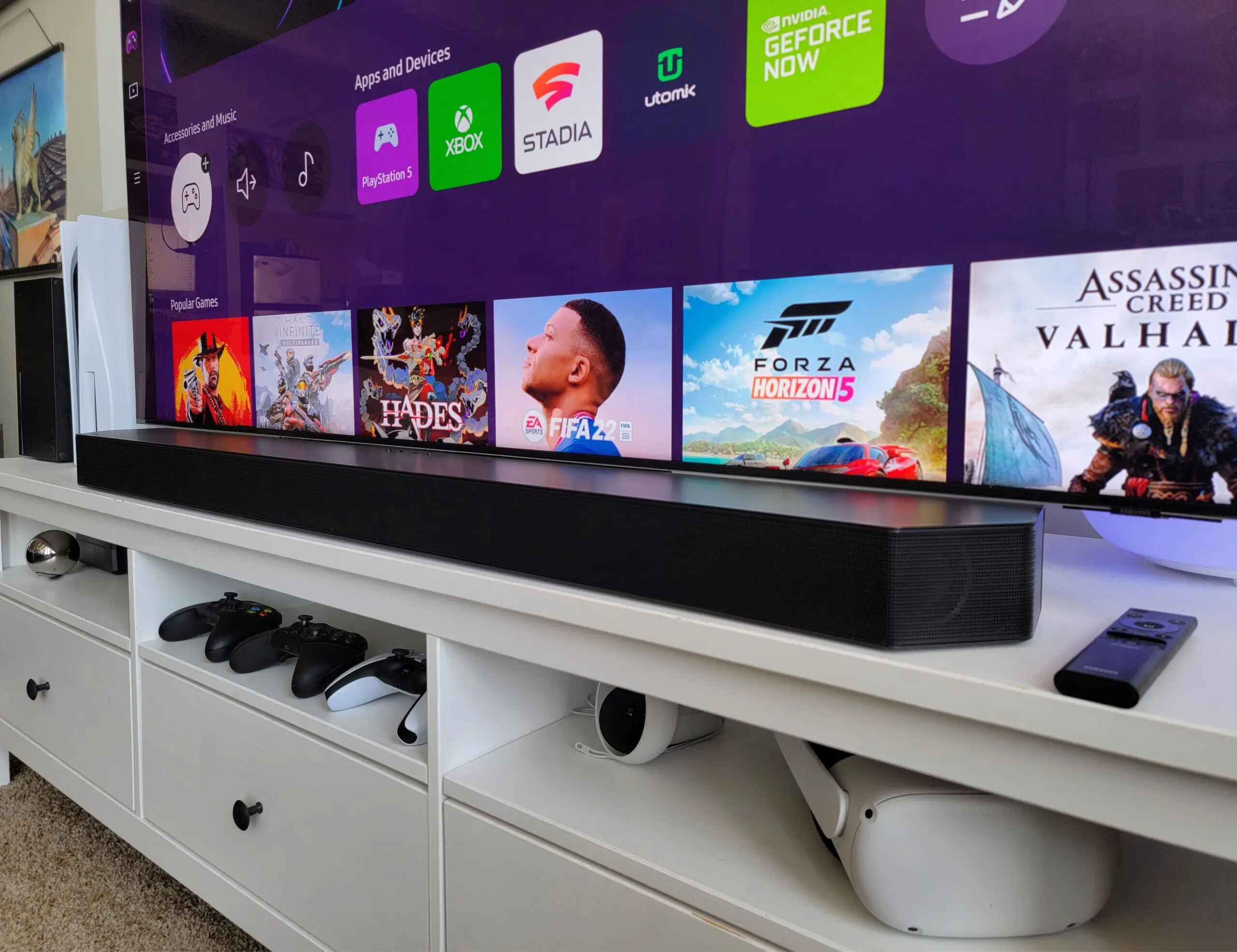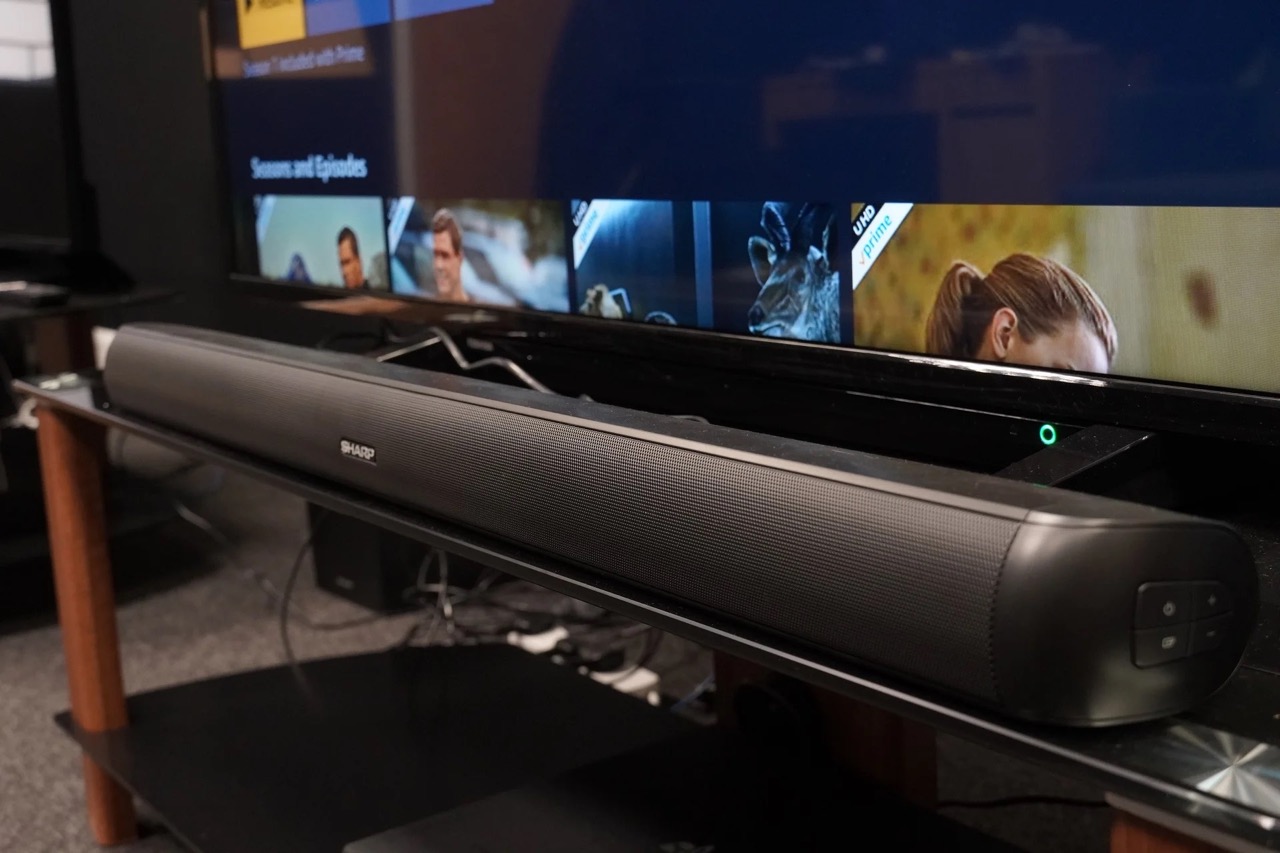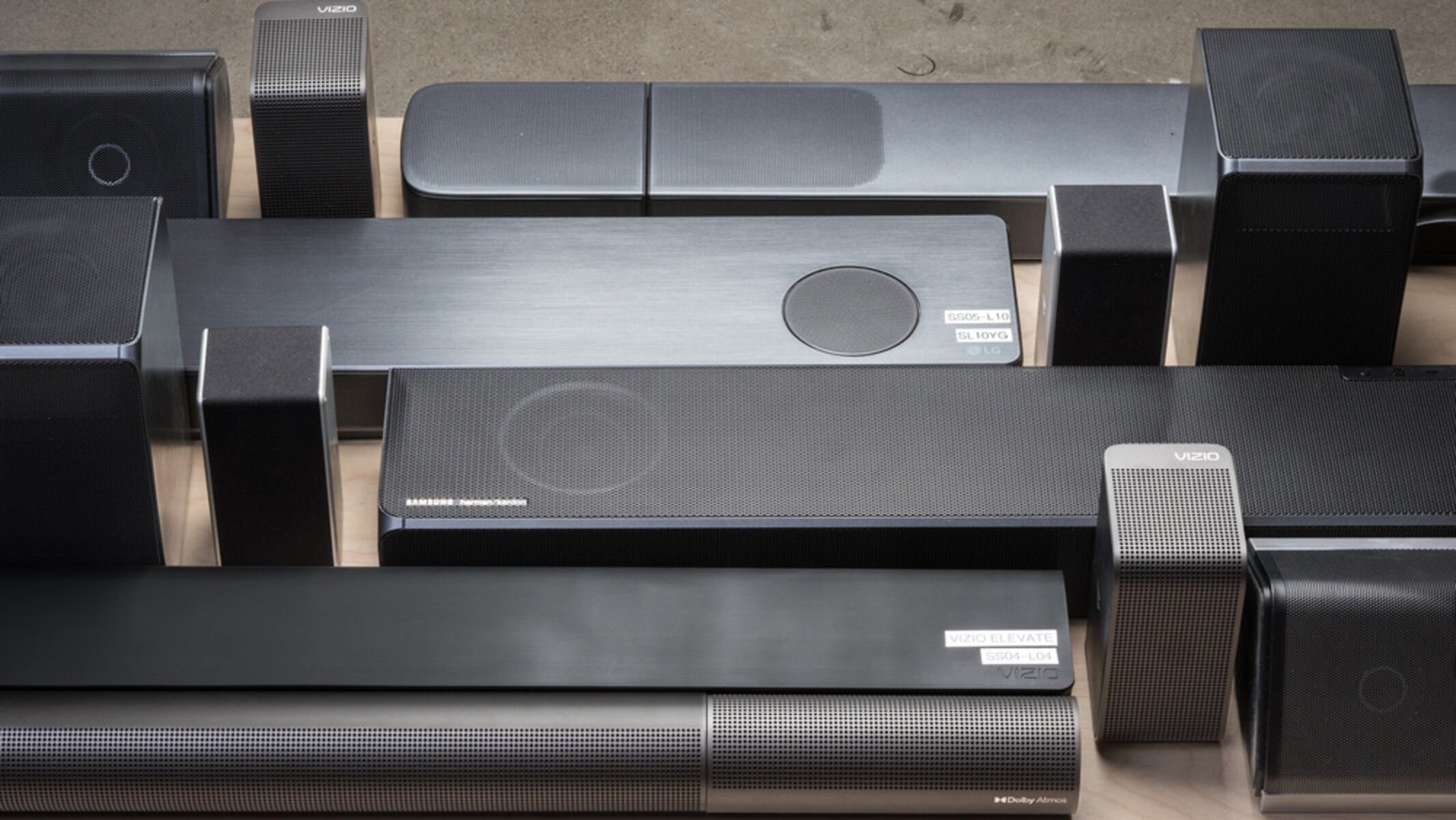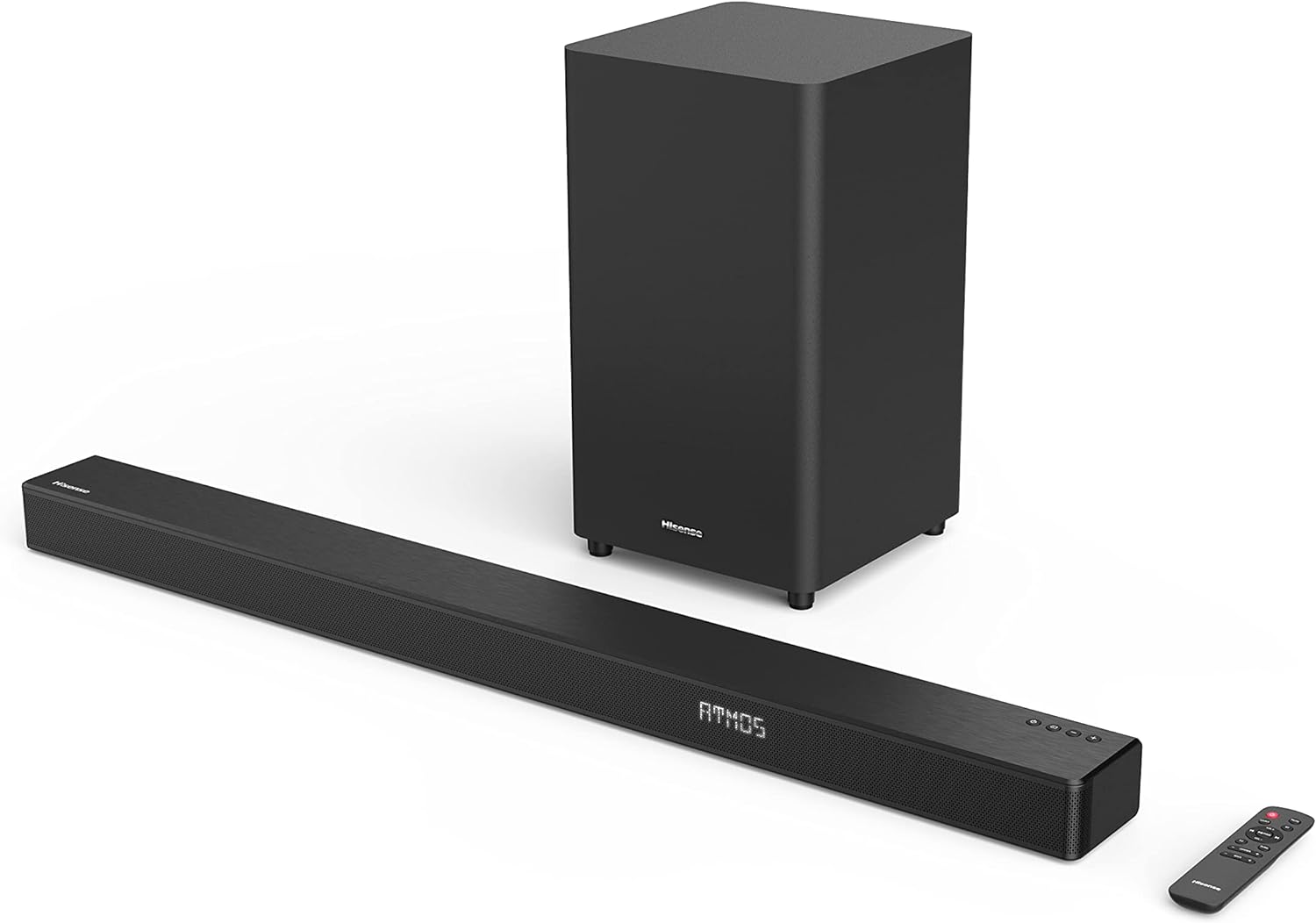Introduction
Welcome to the world of soundbars! Whether you’re setting up a home theater system or simply looking to enhance your audio experience, understanding the terminology can be overwhelming. One term that often comes up is “channels” when referring to soundbars. But what exactly do channels mean in the context of soundbars?
In this article, we will demystify the concept of channels on a soundbar and provide you with a comprehensive understanding of what they entail. From basic 2.0 channel soundbars to advanced Dolby Atmos setups, we’ll explore the different configurations and their implications for your audio setup.
Before we dive into the specifics, let’s first establish what a soundbar is and why it has become a popular audio solution for many households.
A soundbar is a sleek, elongated speaker system that is designed to deliver high-quality sound in a compact and convenient package. It typically consists of multiple speakers arranged in a single enclosure, which helps to create a captivating and immersive audio experience.
Now that we have a basic understanding of what a soundbar is, let’s delve into the world of channels and what they mean in the context of soundbars.
What is a soundbar?
A soundbar is a type of speaker system that is designed to enhance the audio quality of your television or entertainment setup. It is a compact and stylish alternative to traditional bulky speaker setups, offering a streamlined and space-saving solution for delivering immersive sound.
The main purpose of a soundbar is to provide a more dynamic and immersive audio experience compared to the built-in speakers of a TV. As televisions continue to become slimmer, the sound quality often suffers due to the lack of space for high-quality speakers. This is where a soundbar comes in, offering superior audio performance without the need for a complex and cumbersome setup.
Typically, a soundbar consists of multiple speakers and amplifiers housed in a single enclosure. These speakers are strategically positioned to provide better sound dispersion, creating a wider soundstage and ensuring that the audio reaches every corner of the room. Some soundbars also include a separate subwoofer, which is responsible for reproducing low-frequency sounds such as deep bass and rumbling effects.
Soundbars come in various sizes, ranging from compact models that can be easily mounted on a wall to larger options that sit neatly beneath the TV. They are designed to seamlessly integrate with your existing entertainment setup, making it easy to connect and control them using either a wired or wireless connection.
One of the key advantages of a soundbar is its simplicity and ease of use. Unlike a traditional surround sound system that requires multiple speakers and cables to be placed around the room, a soundbar offers a plug-and-play experience. With just a single connection to your TV or audio source, you can enjoy enhanced audio quality in a matter of minutes.
Now that we have established what a soundbar is and why it has become a popular choice for audio enthusiasts, let’s explore the importance of channels in the context of soundbars and how they contribute to the overall audio experience.
What are channels on a soundbar?
When we refer to “channels” in the context of soundbars, we are essentially talking about the number of audio sources or speakers that are present within the soundbar system. Each channel represents a separate audio signal or source, and the number of channels determines the overall audio configuration and capabilities of the soundbar.
The most basic soundbars typically come in a 2.0 channel configuration, which means they have two audio channels – one for the left speaker and one for the right speaker. This provides a stereo sound experience, where the audio is divided between the two speakers to create a sense of directionality and depth.
As we move up the channel hierarchy, soundbars may include additional channels for enhanced audio performance. For instance, a 2.1 channel soundbar would include two main speakers for stereo output along with a separate channel for a subwoofer, which handles low-frequency sounds. This allows for a more balanced audio experience with added depth and bass impact.
Moving further, we have 3.1 channel soundbars, which add a dedicated center channel speaker to the mix. The center channel is responsible for reproducing dialogue and vocals, ensuring clear and crisp audio in movies, TV shows, and other media. This configuration is particularly beneficial for improving speech intelligibility and creating a more immersive audio experience.
For those seeking a more immersive surround sound experience, there are 5.1 and 7.1 channel soundbars available. These configurations include additional surround speakers, usually placed at the sides or rear of the listening area, to create a more enveloping soundstage. This allows for a realistic and three-dimensional audio experience, making you feel like you’re right in the middle of the action.
Finally, we have Dolby Atmos soundbars, which take soundbar audio to a whole new level. Incorporating upward-firing speakers, these soundbars can create a sound experience where audio objects are precisely placed in a 3D space, including overhead, for a truly immersive and cinematic sound experience.
Understanding the different channel configurations on a soundbar is essential to determine the type of audio experience you can expect. Whether you’re looking for a basic stereo setup or a more advanced surround sound system, choosing the right number of channels will greatly impact the audio quality and immersion you can achieve.
Understanding the basics of audio channels
To fully comprehend the concept of channels on a soundbar, it’s important to have a basic understanding of audio channels in general. In audio terminology, a channel refers to an individual audio signal that is sent to a specific speaker or group of speakers.
Channels are typically used to carry specific audio information, such as dialogue, music, or sound effects, in order to create a well-balanced and immersive audio experience. The number of channels directly correlates to the complexity and depth of the audio setup.
In a stereo setup, which is commonly represented as 2.0 channels, two audio channels are used – one for the left speaker and one for the right speaker. This arrangement allows for a sense of directionality and separation of audio, creating a more expansive and engaging soundstage.
As we move beyond stereo, additional channels are introduced to further enhance the audio experience. For example, a center channel is often added to the mix in a 2.1 channel setup. The center channel is responsible for reproducing dialogue and vocals, making it easier to distinguish the spoken words and resulting in clearer and more articulate audio.
Surround sound systems take the audio experience even further with the inclusion of additional channels that are positioned around the listener. In a 5.1 channel setup, five main channels are used – front left, front center, front right, rear left, and rear right – along with a dedicated low-frequency effects (LFE) channel for the subwoofer. This configuration allows for a more immersive audio experience, where sound can be heard coming from different directions, replicating real-life audio scenarios.
Advanced setups like 7.1 and 9.1 channels further expand the soundstage by adding additional surround channels, providing even more precise placement of audio objects and creating a more enveloping atmosphere.
Now, when it comes to soundbars, channels are condensed into a compact single unit. A soundbar can have different channel configurations, ranging from 2.0 to 7.1 or more, depending on the model and intended audio experience. The speakers within the soundbar are strategically positioned to deliver the audio signals from the respective channels, ultimately creating an immersive audio environment.
Understanding the basics of audio channels is crucial in selecting the right soundbar for your needs. It allows you to assess the level of audio immersion you desire, considering factors such as the type of content you consume (movies, music, gaming), the size of your room, and your personal preferences.
0 channel soundbars
2.0 channel soundbars are the most basic configuration available, consisting of two speakers and no separate subwoofer. Each speaker is responsible for handling both the left and right audio channels, creating a stereo sound experience. This means that all audio signals, including dialogue, music, and sound effects, are delivered through these two speakers.
While 2.0 channel soundbars may lack the additional depth and bass impact provided by a subwoofer, they still offer a significant improvement over built-in TV speakers. The dual speakers allow for better sound separation and directionality, resulting in a more immersive and dynamic audio experience.
These soundbars are particularly suitable for smaller rooms or for those who prioritize simplicity and space efficiency. They are easy to set up and typically come at a more affordable price point compared to soundbars with more channels.
Despite their simplicity, 2.0 channel soundbars can still deliver impressive audio quality, especially when paired with advanced sound processing technologies such as virtual sound reproduction or audio enhancement features. These technologies aim to create a wider soundstage and simulate the effect of multiple speakers, providing a more immersive listening experience.
While 2.0 channel soundbars may not offer the same level of surround sound immersion as higher channel configurations, they are a great starting point, especially for those who prioritize clarity and simplicity. They can greatly enhance the audio experience while maintaining a compact and minimalist design.
If you enjoy watching movies or listening to music in smaller spaces, or if you have limited space and want a sound upgrade without the complexity of additional channels, a 2.0 channel soundbar can be a great choice. It offers a noticeable improvement in audio quality, allowing you to enjoy your favorite content with better clarity, depth, and stereo imaging.
It’s worth noting that some 2.0 channel soundbars may also offer the option to add a separate subwoofer or be part of a modular soundbar system, allowing you to expand and upgrade your audio setup in the future. This provides the flexibility to enhance the bass response and overall audio performance as your needs and preferences evolve over time.
In summary, 2.0 channel soundbars offer a simple and streamlined audio solution with improved stereo sound compared to built-in TV speakers. While they may lack the deep bass impact of a subwoofer, they still provide a significant upgrade in audio quality and can be a perfect fit for smaller rooms or those seeking a minimalist design.
1 channel soundbars
2.1 channel soundbars take the audio experience to the next level by adding a dedicated subwoofer to the mix. In this configuration, the soundbar consists of two main speakers for the left and right audio channels, while the subwoofer handles the low-frequency sounds and provides deep bass impact.
The addition of a subwoofer greatly enhances the overall audio performance, allowing for a more balanced and immersive sound experience. The main speakers focus on delivering detailed mid-range and high-frequency sounds, while the subwoofer takes care of reproducing the deep rumbling bass that adds depth and impact to movies, music, and games.
With the separate subwoofer, 2.1 channel soundbars deliver a richer and more dynamic audio experience, filling the room with powerful and enveloping sound. The bass response becomes more pronounced and impactful, giving depth and realism to explosions, musical beats, and other low-frequency effects.
2.1 channel soundbars are especially suitable for those who enjoy movies, music genres that heavily rely on bass (such as electronic or hip-hop), or gaming enthusiasts who want to feel the intensity of the in-game action.
These soundbars provide an excellent balance between enhanced audio quality and simplicity. They are relatively easy to set up and offer a significant improvement over built-in TV speakers, creating a more immersive and enjoyable listening experience without the need for a complex multi-speaker setup.
Another advantage of 2.1 channel soundbars is their flexibility. Many models allow you to adjust the volume of the subwoofer separately, allowing you to find the perfect balance between punchy bass and overall sound. This gives you the freedom to tailor the audio to your preferences and the specific content you’re enjoying.
It’s important to note that not all 2.1 channel soundbars are created equal. The quality and power of the subwoofer can vary between different models, so it’s worth considering higher-end options that offer more robust and accurate bass reproduction for a more immersive and satisfying audio experience.
In summary, 2.1 channel soundbars offer a significant upgrade over standard stereo setups with the addition of a dedicated subwoofer. They provide a balanced and immersive audio experience, with the main speakers focused on delivering detailed mid-range and high-frequency sounds, while the subwoofer adds deep bass impact. Whether you’re watching movies, listening to music, or gaming, a 2.1 channel soundbar offers enhanced audio performance and a more enjoyable audio experience.
1 channel soundbars
3.1 channel soundbars elevate the audio experience by adding a dedicated center channel speaker to the configuration. In addition to the left and right speakers, the center channel is responsible for reproducing dialogue and vocals, resulting in clearer and more articulate audio.
The inclusion of a center channel speaker in a 3.1 channel soundbar setup offers significant benefits, especially for movie enthusiasts and TV show lovers. Dialogue, which is a crucial component of these forms of entertainment, is reproduced with greater clarity, ensuring that every word is heard distinctly. This enhances the overall immersive experience and enables you to fully appreciate the intricacies of the audio mix.
The left, right, and center channels work in harmony to create a more accurate soundstage. The placement of sound effects and instruments becomes more precise, enhancing the sense of depth and immersion in movies and other media that rely heavily on dialogue or multi-channel audio.
3.1 channel soundbars also come with a dedicated subwoofer to handle the low-frequency sounds, delivering deep and impactful bass. The subwoofer augments the overall audio experience, adding an extra layer of richness and depth to explosions, music with heavy basslines, and other sound effects.
These soundbars strike a balance between simplicity and enhanced audio performance. The addition of the center channel speaker significantly improves speech intelligibility, making it ideal for those who prioritize dialogue clarity and vocal reproduction.
When choosing a 3.1 channel soundbar, consider the quality and power of the individual speakers, as well as the subwoofer. Look for models that provide a well-matched and well-tuned audio setup, ensuring seamless integration between the speakers and delivering a cohesive and immersive sound experience.
3.1 channel soundbars are particularly suited for those who enjoy movies, TV shows, and other content where dialogue plays a vital role. They allow you to fully immerse yourself in the action on the screen, hearing every word spoken with exceptional clarity. The addition of the subwoofer ensures that you don’t miss out on the deep bass impact that adds excitement and realism to your favorite movies, music, and games.
In summary, 3.1 channel soundbars take the audio experience to the next level by adding a dedicated center channel speaker to reproduce dialogue and vocals. This configuration enhances speech intelligibility and creates a more accurate soundstage. Paired with a separate subwoofer for impactful bass, 3.1 channel soundbars strike a balance between enhanced audio performance and simplicity, making them an excellent choice for movie and TV enthusiasts who seek clear dialogue and immersive sound.
1 channel soundbars
5.1 channel soundbars offer a true surround sound experience by incorporating additional surround speakers into the audio setup. In addition to the left, right, and center channels, which are responsible for audio projection from the front, these soundbars include two additional speakers placed at the sides or rear of the listening area for an immersive surround sound effect.
The inclusion of rear or surround speakers in a 5.1 channel soundbar setup adds a new dimension to your audio experience. These speakers create a more enveloping soundstage, allowing sounds to be heard coming from different directions. You’ll feel truly immersed in the action as audio effects move around you, replicating a theater-like experience.
While the front speakers handle the primary audio signals, the surround speakers enhance the sense of spaciousness and provide a more realistic and three-dimensional audio environment. This is particularly beneficial for movies, sports, music, and gaming, where precise audio placement can greatly enhance the overall immersion and engagement.
Alongside the front and surround speakers, a dedicated subwoofer is included in a 5.1 channel soundbar setup to reproduce low-frequency sounds and deliver powerful bass impact. The subwoofer enhances the depth and richness of explosions, music, and other bass-heavy elements, adding intensity and realism to your audio experience.
5.1 channel soundbars strike a balance between visual aesthetics and audio performance. With fewer wires and speakers compared to traditional surround sound setups, they offer a cleaner and more streamlined setup without compromising on audio immersion.
When selecting a 5.1 channel soundbar, pay attention to the quality and positioning of the surround speakers. Opt for models that provide well-matched and well-tuned speakers for a seamless audio experience. It’s also important to consider the power and placement of the subwoofer to ensure optimal bass reproduction and integration with the rest of the system.
5.1 channel soundbars are an ideal choice for those seeking a complete and immersive audio setup. They bring cinematic audio quality into your home, allowing you to enjoy your favorite movies, music, and games with a heightened sense of realism and immersion.
Keep in mind that 5.1 channel soundbars may require a larger space to accommodate the placement of rear or surround speakers. However, the overall simplicity and convenience they offer, coupled with the enhanced audio experience, make them a popular choice for home theater enthusiasts.
In summary, 5.1 channel soundbars provide a true surround sound experience by incorporating additional rear or surround speakers. These speakers create a more immersive audio environment, enhancing the sense of depth and realism. Paired with a dedicated subwoofer for impactful bass, 5.1 channel soundbars strike a balance between visual aesthetics and audio performance, delivering an immersive and engaging audio experience for movies, music, and gaming.
1 channel soundbars
7.1 channel soundbars offer an even more immersive audio experience by expanding on the 5.1 channel setup. In addition to the left, right, center, and surround speakers, these soundbars include two additional surround speakers for a more precise and immersive soundstage.
The two additional surround speakers in a 7.1 channel soundbar setup provide an enhanced sense of directionality and immersion. They allow for more precise placement of sound effects, creating a more realistic and enveloping audio experience. With audio coming from multiple directions, you’ll feel fully immersed in the content you’re watching or listening to.
The front three speakers (left, center, and right) handle the primary audio signals, ensuring clear and balanced sound reproduction, especially for dialogue and vocals. The surround and rear speakers envelop you in a layered sound experience, making it feel like you’re in the middle of the action.
To add to the immersive audio experience, 7.1 channel soundbars also come with a dedicated subwoofer for deep, impactful bass. The subwoofer complements the main speakers by reproducing low-frequency sounds, providing a rich and cinematic audio experience with rumbling effects and deep bass notes.
With their wider soundstage and more precise audio placement, 7.1 channel soundbars are particularly well-suited for larger rooms or dedicated home theaters. They create an immersive experience that brings movies, music, and games to life, delivering dynamic and realistic audio effects that enhance the overall entertainment experience.
When selecting a 7.1 channel soundbar, consider the quality and placement of the additional surround speakers, as well as the power and integration of the subwoofer. Look for models that provide well-matched and well-tuned speakers to ensure a seamless audio experience across all channels. Additionally, some 7.1 channel soundbars may offer advanced sound processing technologies, such as Dolby Atmos or DTS:X, for an even more captivating audio experience.
7.1 channel soundbars offer a higher level of audio immersion and accuracy compared to lower channel configurations. They are an excellent choice for those seeking a true home theater experience, providing a surround sound setup that matches the realism and excitement of a movie theater.
Keep in mind that 7.1 channel soundbars may require more space for placement of the additional surround speakers, so it’s essential to ensure that you have adequate room to accommodate them. However, the enhanced audio experience and immersive qualities of 7.1 channel soundbars make them a worthwhile investment for audio enthusiasts and home theater lovers.
In summary, 7.1 channel soundbars expand on the 5.1 channel setup by adding two additional surround speakers. This configuration offers a more precise and immersive soundstage, enveloping the listener in an audio experience that replicates a theater-like atmosphere. With the dedicated subwoofer, 7.1 channel soundbars provide deep bass impact, creating a dynamic and captivating audio experience for movies, music, and gaming in larger rooms or dedicated home theaters.
Dolby Atmos soundbars
Dolby Atmos soundbars represent the pinnacle of audio technology, offering a truly immersive and three-dimensional sound experience. Dolby Atmos is an audio format that goes beyond traditional surround sound, allowing sound to be precisely placed and moved in a three-dimensional space, including overhead.
Unlike traditional surround sound setups, Dolby Atmos soundbars use advanced speaker arrays and upward-firing speakers to create an overhead sound effect. This overhead audio placement adds a new dimension to the audio experience, making you feel like you’re truly in the middle of the action.
By enabling sound to move in a three-dimensional space, Dolby Atmos soundbars provide a more realistic and immersive audio experience. Audio objects, such as raindrops falling or airplanes flying above, can be precisely positioned in the room, creating a detailed and captivating sound environment.
With Dolby Atmos, audio can move seamlessly and realistically around the listener, as if the sound is coming from all directions. This adds depth, height, and an incredible sense of realism to movies, TV shows, music, and games.
Dolby Atmos soundbars typically come with multiple speakers, including front, center, and surround speakers, as well as upward-firing speakers for the overhead audio effect. The number of speakers can vary depending on the specific soundbar model and its configuration.
In addition to the speaker setup, Dolby Atmos soundbars require content encoded in the Dolby Atmos format to fully utilize their capabilities. Many streaming services, Blu-ray discs, and other media sources now offer content with Dolby Atmos support, providing an ever-growing library of immersive audio experiences.
When setting up a Dolby Atmos soundbar, it’s important to consider the room acoustics and the compatibility of the soundbar with your existing setup. Some models may require additional speakers or equipment to fully achieve the Dolby Atmos effect.
While Dolby Atmos soundbars offer the utmost in audio immersion and realism, they do require a dedicated space and investment. The additional speakers and advanced features contribute to a higher cost compared to other soundbar configurations.
If you are a true audio enthusiast and want to recreate the cinema experience in your home or have a dedicated home theater setup, Dolby Atmos soundbars are an excellent choice. They deliver unparalleled audio immersion, allowing you to fully immerse yourself in your favorite movies, music, and games with breathtaking sound quality and immersive effects.
In summary, Dolby Atmos soundbars offer a cutting-edge audio experience through the use of advanced speaker arrays and overhead audio placement. They provide a truly immersive and three-dimensional sound experience, enabling sound to move precisely in a 3D space. With its realistic audio placement and effects, Dolby Atmos soundbars bring movies, music, and games to life, offering audio enthusiasts the pinnacle of home theater immersion.
Conclusion
Soundbars have become an increasingly popular audio solution due to their convenience, compact design, and enhanced audio performance compared to built-in TV speakers. Understanding the concept of channels in soundbars is essential for selecting the right audio setup that suits your needs and preferences.
Whether you opt for a 2.0 channel soundbar for simplicity and space efficiency, a 2.1 channel soundbar for added bass impact, a 3.1 channel soundbar for clearer dialogue reproduction, a 5.1 channel soundbar for a true surround sound experience, a 7.1 channel soundbar for a more precise and immersive audio environment, or a Dolby Atmos soundbar for the ultimate three-dimensional sound experience, each configuration offers unique benefits and audio immersion.
When choosing a soundbar, consider factors such as room size, budget, desired audio immersion, and personal preferences for audio content like movies, music, or gaming. Look for well-matched speakers, consider the quality of the subwoofer, and explore additional features like advanced sound processing technologies to enhance your audio experience further.
Whether you’re watching your favorite movies, listening to music, or enjoying the latest video games, a soundbar with the right channel configuration can greatly enhance the audio quality and create a more immersive and enjoyable entertainment experience.
Remember to constantly evaluate your audio needs and preferences as they may evolve over time. If you find yourself craving a more immersive and encompassing audio experience, don’t hesitate to upgrade to a higher channel configuration or explore advanced audio technologies.
From 2.0 channel soundbars to Dolby Atmos soundbars, there’s a soundbar configuration out there to suit every audio enthusiast. So, go ahead and choose the one that best fits your needs, sit back, and enjoy the captivating sound quality that a soundbar brings to your home entertainment setup.







